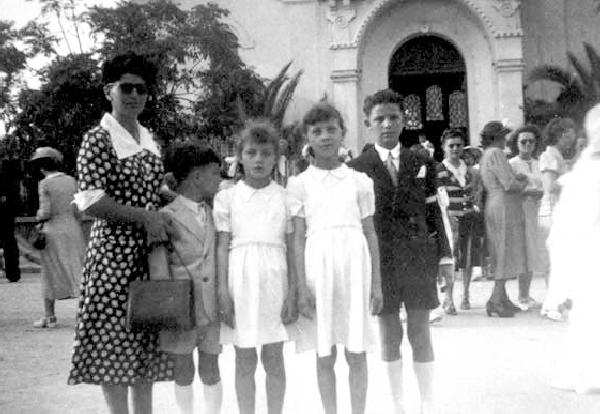
French First Communion Suits: 20th Century Post-War Era (1945-1970)

Figure 1.--Here we see a French boy doing his First Communion in 1951. I'm not sure just where this is. Notice the palm trees in the back ground. Southern France has a warm clinmate, but I don't hink that they have pakm trees. Perhaps our French readers will know where this is. Could this be New Caledonia? A French reader tells us, "This image could easily have been taken in France. On the French Riviera one can found a lot of palm trees as well as orange and lemon trees. It never snows. Of corse in the Alpine montain region , the temperature is very cold in winter. A large part of the Atlantic French coat has with a moderate climate because of the Gulf stream."
|
|
French children continued to wear special outfits for First Communion after World War II. The girls still wore junior wedding dresses. The boys' outfits were more varied. The predominately short pants styles for First Communion suits began to change in the 1950s. Other were very formal tuxedos or Eton suits. These more formal suits were sometimes also worn with short pants and white kneesocks. Available information on 1960s suits suggest mostly black suits. Many of the First Communion suits, while black or dark colors, were worn with white kneesocks. While many Catholic schools required boys to wear short pants, often blue shorts, with white kneesocks, most boys usually wore grey or darker colored kneesocks with short pants suits. Boys continued wearing large bows on their arms during the post-war era. The drawings shown here from the fashion magazine Thiery Sin their Spring-Summer 1956 show mostly double breasted suits. I do not think that double breasted suits were that popular in France that most suits were in that style. Perhaps the double breasted style was considered more formal and thus dominated the styles displayed. Some Catholic schools continued to have the boys dress up in identical cassocks for the First Communion ceremony. This same style was worn by Swiss boys during First Communion and it may well havebeen used in other countries as well. We have found one 1950s portrait, but unsure about the nationality. Many readers believe that it may be European, possibly French.
French children continued to wear special outfits for First Communion after World War II. The girls still wore junior wedding dresses. The boys' outfits were more varied. We see children wearing pre-War styles for their First Communion outfits after World War II. Conditiions were very difficult immediately after the War, but First Communiion was very important. Conditions rapidly improved, especially after the Marshall Plan help stimulate the economic recovery. Increasing personal income in the 1950s allowed French families to afford smart outfots for the children. The girls wore white junior wedding dresses. The boys wore a variety of outfits including suits, sailor suits, and even formal tuxedo suits. There were also cassocks. The suits were often worn with short pants and white kneesocks. The predominately short pants styles for First Communion suits began to change in the 1950s. Short pants began to become somewwhat less common, especially by the lsate-1960s.
Individual Accounts
We have a few photographs showing boys doing their First Communions in the Post-War era.
Here we have a Breton boy in his First Communion suit with his family. A British reader writes, "Here is a family First Communion photograph from Britanny. It is interesting in that the boy taking communion is dressed as an English 19th century boy would be! The elder women are wearing the traditional Breton lace bonnets and are dressed in black. I always like to identify Mum's and Dad's features in Family photos and I would say that the two older boys and their sister take after the Mum - standing between them - (facial features!) yet the youngest boy takes after the Father (behind him to the right). Anyway I may be wrong! Other comments - the women wear gloves (the girl included) but so does the boy taking communion and they (the women) wear hats but the boys/men do not. Also the older boys seem to be allowed to have longer hair but not the younger one. Finally as always short socks for girls and boys seem to be "dresssy" in France (Britanny but that may be debatable!) yet here in England kneesocks would be the norm - especially in that era except for the very youngest boys (up until 8 or 9 years).
HBC

Navigate the Historic Boys' First Communion pages:
[Return to the Main French 20th century First Communion page]
[Return to the Main First Communion page]
[Renewals]
[America]
[Canada]
[France]
[Spain]
[Switzerland]
Navigate the Historic Boys' Clothing Web Site:
[Introduction]
[Activities]
[Biographies]
[Chronology]
[Clothing styles]
[Countries]
[Bibliographies]
[Contributions]
[FAQs]
[Glossaries]
[Images]
[Links]
[Registration]
[Tools]
[Boys' Clothing Home]
Navigate the Historic Boys' Clothing Web chronological pages:
[The 1920s]
[The 1930s]
[The 1940s]
[The 1950s]
[The 1960s]
[The 1970s]
Navigate the Historic Boys' Clothing Web style pages:
[Short pants suits]
[Blazers]
[Jackets]
[Kilts]
[Sailor suits]
[Sailor hats]
[Ring bearer/page costumes]
[Shortalls]
Created: 5:40 PM 4/7/2005
Last edited: 6:40 PM 7/3/2010



